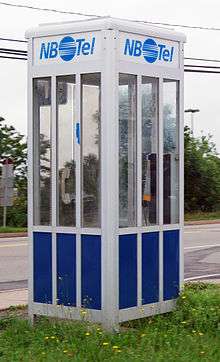Bell Aliant
.svg.png) | |
| Private subsidiary | |
| Industry | Communications Services |
| Founded | 1999 |
| Headquarters | Atlantic Canada |
Key people | Karen Sheriff[1] (President and CEO) |
| Products | Fixed line, Fixed Broadband, IPTV |
|
| |
| >$212 million | |
| Total assets | $4.1 billion |
Number of employees | 2000 (2009) |
| Parent | BCE |
| Website | Bell Aliant Home Page |
Bell Aliant Inc. (Formerly Aliant Telecom Inc.) is a communications company providing services in various areas throughout Atlantic Canada.
Bell Canada, which had been the largest shareholder in the company and most of its predecessors throughout their respective histories, took full ownership of Bell Aliant in late 2014. In announcing these plans, Bell Canada indicated that the Bell Aliant brand name will continue to be used in Atlantic Canada.[3][4]
History
The current firm is the successor to Aliant Telecom Inc, formed from the 1999 merger of Maritime Telephone and Telegraph Company (MT&T), Island Telecom (which had been majority-owned by MT&T), Bruncor (parent of NBTel), and NewTel Enterprises (parent of NewTel Communications), then the four main incumbent telephone companies in Nova Scotia, Prince Edward Island, New Brunswick and Newfoundland and Labrador respectively. Bell Canada was the largest shareholder of MT&T, Bruncor, and NewTel prior to the merger, and received a 53% stake in the merged company, Aliant. At the time that Aliant Inc. was being formed, the executives of the four merging companies agreed to a co-operative management strategy which would see no specific province have a Bell Aliant head office; instead the headquarters functions would be spread across its constituent companies.

On April 14, 2006, Bell and Aliant announced plans to merge Aliant's operations into those of Bell. Specifically, Aliant's "high growth" wireless and retail (DownEast) networks would be folded into Bell's wholly owned Bell Mobility and Bell World operations, respectively. Aliant, under a new income trust structure, would acquire Bell's "regional" landline operations (i.e. outside of major city centres) in Ontario and Quebec.[5] This created the significant challenges involved with merging English-speaking operations with French-speaking operations. The transaction was completed on July 10, 2006, and saw the appointment of Stephen Wetmore, formerly of Bell, as President and CEO. Bell Canada retained 45% of the restructured Aliant.[6] Fund units representing about 28.5% of Bell Aliant were distributed to shareholders of Bell's parent company, BCE. Shareholders of the former Aliant Inc. received units representing 26.5% of the firm. (The company would convert back to a regular corporation at the end of 2010.)



The purpose was to separate out the more stable (or low-growth) parts of Bell's holdings, i.e. wireline operations in markets with relatively little competition, to satisfy investors. The restructuring was not expected to have any effect on end consumers in terms of existing pricing or bundling practices. Meanwhile, Bell Canada proper continues to have full control over its wireless and satellite/cable operations throughout Canada, as well as wireline operations in major centres such as Toronto, Ottawa, Montreal, and surrounding areas.
Bell Aliant has also assumed Bell's 63.4% interests in both NorthernTel and Télébec. Since January 30, 2007, both are 100%-owned by Bell Aliant. Both firms continue to operate their own wireless networks.
On January 1, 2013, Bell Aliant completed its purchase of Dryden Municipal Telephone Service (DMTS), a municipal telephone utility in Dryden, Ontario.[7] Bell Aliant plans on continuing to use the DMTS brand name.
On July 23, 2014, BCE announced it would privatize Bell Aliant by acquiring the interest of Bell Aliant’s public minority shareholders. On October 3, 2014, BCE announced the successful completion of its tender offer to purchase all outstanding Bell Aliant publicly held common shares.On November 3, 2014, BCE announced the formal close of the transaction as BCE acquired all remaining Bell Aliant common shares not acquired under BCE’s tender offer through a compulsory acquisition effective October 31, 2014. Bell Aliant common shares were de-listed from the Toronto Stock Exchange (TSX) on October 31, 2014.[3][4]
In October 2014, Bell Aliant completed its acquisition of Ontera, the telecommunications division of the Ontario Northland Transportation Commission (a Crown agency of the Government of Ontario).[8]
Operations
Currently, the company operates as "Bell Aliant" in Atlantic Canada. The Atlantic Canada services were known as simply "Aliant" until summer 2008. Similarly, the former Aliant wireless and retail networks initially operated under the "Aliant" brand in Atlantic Canada, albeit now under the direct control of Bell. Wireless services transitioned to the Bell brand in April 2008.[9]
In Atlantic Canada, Bell Aliant's services include high-speed and dial-up internet access, wireline telephone service, and IPTV cable television. Its main competitors are the region's incumbent cable providers, EastLink and Rogers Communications, who had eroded on Bell Aliant's market share until mid-2009,[10] at which time Bell Aliant launched Fibe, and as of mid-2011 was available to 294,000 homes and businesses in Atlantic Canada.
Area Codes
- Area codes 902 and 782
- Area code 506
- Area code 709
- Area codes 418 and 581
- Area codes 819 and 873
- Area codes 705 and 249
- Area code 807
- Bell Canada
- Cybertip.ca
References
- ↑ "Bell Aliant announces Karen Sheriff as new President and CEO". October 27, 2008.
- ↑ "Aliant Inc. 2005 Annual Information Form". Retrieved 2006-07-11.
- 1 2 "BCE announces successful completion of Bell Aliant common share tender offer, transaction on track to close on or about October 31"
- 1 2 "Bell Aliant Privatizaton"
- ↑ "Notice of meeting and management Information Circular" (PDF)
- ↑ "Jay Forbes to step down as CEO of Aliant Inc."
- ↑ "Dryden Completes Sale of DMTS Lineline to Bell Aliant"
- ↑ "Bell Aliant acquires Ontera"
- ↑ "Bell Mobility"
- ↑ Financialpost.com, Residential Customers Leaving, Declining Market Share